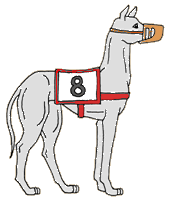
Ear Tattoos
Tattoos are applied by the breeder at 3 months of age to puppies to ensure a permanent and positive ID of each potential racer.
Birth date
The right ear tells the month and year the puppy was born.
Example 1: 88A means the puppy was born in the eighth(8) month of 1988 (8), and is the first (A) dog in the litter.
Example 2: 122E means the puppy was born in the twelfth month (12) of 1992 (2) and is the fifth (E) dog in the litter.
Registration ID
The left ear has 4-5 digits and is the litter registration number with the National Greyhound Association. This number is checked every time the dog is raced to ensure it is the correct dog racing.
You can learn about your dog’s racing history at Greyhound Data. You can write to that owner and send papers to get your greyhound’s ownership transferred over to you.
Their Former Life
Greyhound litters usually produce 4-10 puppies. Once weaned, puppies are placed in a fenced area to play and grow. Usually when they are around one year old they are kenneled and their track training begins. They are taught to chase a lure and race counter clockwise. It is usually at this time that it is determined whether they will become racers or not.
When greyhounds are kenneled, they are kept crated for the majority of their time. Crates are placed one on top of another, side by side. Crates are usually 3 feet by 2 feet.
Trainers usually care for 20-60 dogs within a kennel. Greyhounds are let out, muzzled, with a pack of other same-sex greyhounds up to 5 times a day, depending on the kennel, to relieve themselves. A racing or training greyhound is also let out of the kennel to go to the track and run 5/16th of a mile up to twice a week.
They are fed once a day with a variety of food — usually soft, high-protein and inexpensive. They are not neutered or spayed.
This is what a greyhound knows until you bring him home.